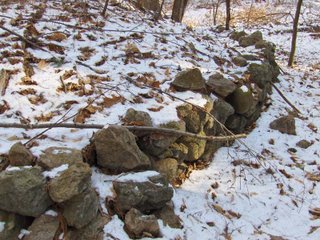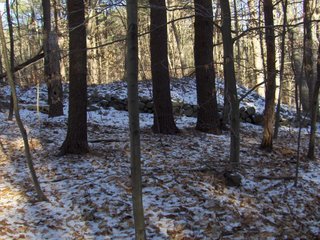 By way of thanking her for what she showed me, let me at least offer some free advertising for her flower essences business. Here is her Business Card.
By way of thanking her for what she showed me, let me at least offer some free advertising for her flower essences business. Here is her Business Card. She brought me over to the northwest corner of the conservation land and showed me the biggest rock pile ever. This is about 50 feet from left to right, made completely out of broken bedrock:
She brought me over to the northwest corner of the conservation land and showed me the biggest rock pile ever. This is about 50 feet from left to right, made completely out of broken bedrock: I think this is larger than the pile at Whipple Hill in Lexington. This pile sits in a hollow in the hill that looks for the world like a sand and gravel quarry. But the material of this pile is the same pink quartzite which, I think, is bedrock, not glacial till and so, not the material extracted from a sand and gravel quarry. Of course I cannot be sure what is what but certainly this is an interesting rock pile. Here is a view down the face of the pile, followed by a picture of the retaining wall at the far end:
I think this is larger than the pile at Whipple Hill in Lexington. This pile sits in a hollow in the hill that looks for the world like a sand and gravel quarry. But the material of this pile is the same pink quartzite which, I think, is bedrock, not glacial till and so, not the material extracted from a sand and gravel quarry. Of course I cannot be sure what is what but certainly this is an interesting rock pile. Here is a view down the face of the pile, followed by a picture of the retaining wall at the far end:
 Here are some other views from that direction (to the left in the first picture):
Here are some other views from that direction (to the left in the first picture):
 The upper surface was pretty level but looks a little tilted in these pictures [The picture of Sarah Fuhro is from on top of the pile] . The retaining wall on the front part looked to have been caved in a bit:
The upper surface was pretty level but looks a little tilted in these pictures [The picture of Sarah Fuhro is from on top of the pile] . The retaining wall on the front part looked to have been caved in a bit: But there was some effort expended there.
But there was some effort expended there.As I said, the pile seems to site in a hollow of a sand pit. All around are little mounds and, what I interpreted as bullldozer piles. One auxilliary mound had a pile on it:
 I should have payed more attention to these mounds. Sarah Fuhro thought they were moundbuilder-like. Perhaps she is right. The pile is facing southeast over a water source.
I should have payed more attention to these mounds. Sarah Fuhro thought they were moundbuilder-like. Perhaps she is right. The pile is facing southeast over a water source.This pile leaves me with a number of questions.
- How did the pile get to be the shape it is now?
- What might have been its original shape?
- Is the broken ledge-rock something that could be quarried at a sand and gravel pit?
I think the retaining wall is a pretty good indication that it is probably Indian in origin. It demonstrates a level of care in construction that simply wasn't practical from a quarrying standpoint.
ReplyDeleteFollowing that line of thinking, I would theorize that the original shape of the pile might have been dictated by the natural terrain underneath. Certainly its shape might have been altered over the years by a number of factors -- natural events, human disturbances, etc.
I think a more important question surrounds the significance of its placement.